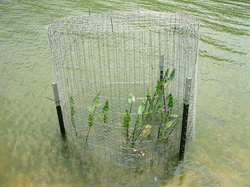 4’ diameter cages 4’ diameter cages OK… I have to admit something. I was going to totally ignore an early failure of mine with Fyrne Lake in this series, but my story wouldn’t be complete if I do! In my last article I steered clear of mentioning any of my early efforts at establishing plants in the lake. I’m sure that’s because it was a total and utter DISASTER! It consumed an amazing amount of time, effort and not a small amount of money. You see, I thought I had it all figured out. This successful entrepreneur from Florida (me) was going to outsmart these backwoods Tennessee grass carp (actually they’re from Asia – but I didn’t know that at the time). It all started with my desire to establish plant life in Fyrne Lake. Ideally a lake or pond ecosystem includes aquatic plants in the shallows with larger natural and/or manmade structures stretching out into the depths. I knew I could handle the larger structures (see my last article). I also was aware that establishing aquatic plants would be a challenge until we reduced the number of grass carp in the lake. Reducing their numbers would take time and I didn’t want to wait! I immediately started devising a plan to create multiple fenced in “carp free zones” in the shallower areas of the lake. I realized that the grass carp would consume any plants that grew out beyond the fence, but that was part of my plan. I knew we would eventually thin the grass carp out enough that the aquatic plants’ growth would reach a critical mass where the plants would grow out beyond the fence more quickly than they could be consumed. Once that happened, we would be winning the war against the grass carp. At least that was my plan. Before we created these barrier structures, we needed to select what plants would go in them. Selecting the right mix was going to be important and I had to avoid ANY that might take over the lake. We were lucky; most of Fyrne Lake’s bottom exceeded 6 feet which was the max depth that most (but not all) aquatic plants could survive. I called my lake consultant, spent hours researching on the internet and contacted several aquatic plant nurseries. Eventually, I settled upon three species: Pickerel Weed (Pontederia cordata), American Pondweed (Potamogeton nodosus), and Fragrant Water Lily (Nymphaea odorata). Each plant performed a specific function in the lake. The Pickerel Weed would occupy the most shallow zone, from the wet soil of the shoreline to 6 inches of water depth with some plants creeping out to as much as 18 inches. In full sun Pickerel Weed will densely occupy this zone creating a shore erosion barrier from waves or wake. The American Pondweed would share the shallow water zone of the Pickerel Weed and beyond stretching out to 36 inches of water depth with some plants surviving up to 48 inches. The dense growth of these two aquatic plants would provide exactly what our shoreline baitfish species (fathead minnows and golden shiners) needed to survive and multiply, thereby significantly increasing Fyrne Lake’s food supply. The Fragrant Water Lily (commonly known as lily pads) would perform a completely different role in my plan. Their structure isn’t nearly as dense, consisting of long slender steams reaching up from the bottom and ending with floating leaf 4 to 12 inches in diameter. Their function is to provide structure for game fish to hide among to ambush baitfish and hopefully fishing lures! These plants will grow in water depths of up to 6’ completing my planned shoreline fish habitat without taking over the areas of the lake with greater depths. Two of the three aquatic plants also had a cool side benefit… beautiful blooms! Many of you are probably familiar with the large white floating flowers associated with lily pads, but are you familiar with the unique purple flowers of the Pickerel Weed? These plants grow from 2 to 4 foot tall with spikes containing multiple small (less than ½ inch) violet flowers each with two yellow spots. The nectar attracts bees (great for our honey production), the seeds are a great food source for ducks while their leaves are a treat for deer and muskrats (more on that later). Now it was time to create the grass carp free zones! We started with 15 round structures made from 50’ rolls of 4’ tall perimeter fencing wire. Each one would be installed in 1 to 2 1/2 foot of water toward the shallower end of Fyrne Lake’s coves. It took three of us working a full week to install and plant these structures. Would they keep out the carp? We would soon find out! Soon the cages were filling up with plants! We also discovered an exciting side benefit. Baitfish and gamefish fry had quickly discovered the sanctuary they provided. The summer went on and the lily pads began blooming! They were beautiful and the cages were working! Wow, it looked like things were turning out amazingly well. But I was about to discover that I was celebrating prematurely. As the summer was wearing on we noticed a few lily pads reaching out beyond the fence. That was a good sign. And the fact that they disappeared soon after wasn’t a surprise; it was expected. However it wasn’t long before we noticed other plants disappearing… from within fencing! How could that be?!? Were the grass carp finding a way in? Fisherman had noticed that the grass carp had been bumping up against the cages trying to get to this new and very interesting salad. But these fish were huge weighing in at 40 pounds or better! There was no way any of them could fit through the small openings in the fence. So why were the plants disappearing from the interior of the rings? I put on my waders and we headed out into the lake to check the structures out. No holes! What was happening? The answer soon came from a fisherman, “Hey Kevin! I just saw a muskrat in the lake with a lily pad trailing behind!” OH NO! I wasn’t just fighting the grass carp, the muskrats have joined in! Desperately I attempted to salvage our work. We figured the muskrats were squeezing through the 2” x 4” holes in the fencing. We purchased 15 roles of fine mesh wire fencing and replacement plants. Then we proceeded to wrap each fence ring with the new material. For a time our efforts seem to be working. The plantings recovered and again started reaching out beyond their enclosure. Then the cycle began repeating itself. Plants started disappearing from the outside, then the inside of several enclosures. The signs pointed back to the muskrats. It appeared that once attracted back to the rings by the plants growing out through the exterior, they figured out how to climb the fence to reach the interior. They’re intelligent little varmints!!! We had to regroup! A season passed and I decided to give it one more major try. THIS TIME I thought I had figured out a FINAL solution … at least I hoped! First, we removed over half of the existing fence rings where the plants had been decimated. Next we created 50 smaller diameter (4 foot) “enclosed” cages that included a wire mesh top. Surely this design would keep out the muskrats! This plan quickly evolved into a huge project consuming several weeks of effort in construction and installation. Finally our job was complete and as before, plants (and small fish) started to thrive within the comfort and protection of our structures. It looked like our efforts were finally beginning to pay off. After a steep learning curve it looked like we were winning the war. But no, not even close! Structure after structure soon were emptied of all plant life … but how? It turned out that these cute, little and apparently very intelligent aquatic mammals were as determined to get to my plants as I was to protect them. After a few months of watching their crop grow safely protected from the grass carp from within these new structures, they simply burrowed under the fence to harvest the bounty! I was devastated and admitted that I had met my match and surrendered to the reality of the situation. We would waste no more effort on establishing aquatic plants until the grass carp (and muskrats) were under control! Until then I would concentrate on adding natural and manmade structure to the lake. This experience taught me two valuable lessons. There are usually more variables (and enemies) in a situation than you initially see and when you think you’ve got it all figured out… check again! Over confidence can be your own worst enemy. Managing Fyrne Lake has been much more than I ever bargained for! However, I’m not complaining! I love the experiences I’ve had tackling each successive challenge in my pursuit of making Fyrne Lake a first class fishery. More articles are in the works for future issues that will cover other aspects of our management of Fyrne Lake and our efforts to care for the land, wildlife and forest of my family’s farm. I’m looking forward to sharing them with you! |
AuthorKevin Griffith Archives
September 2018
Categories |
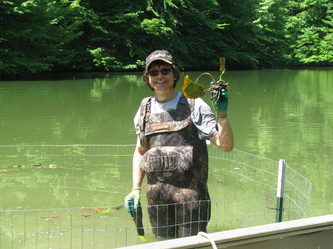
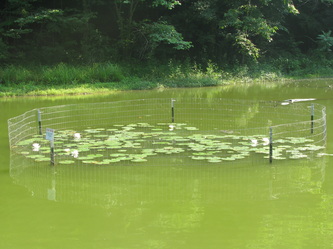
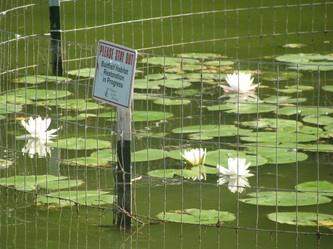
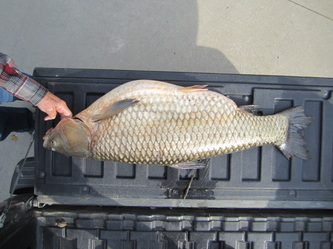
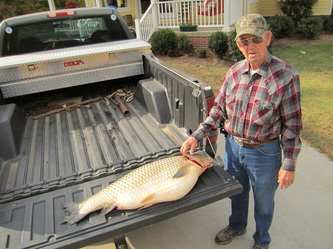
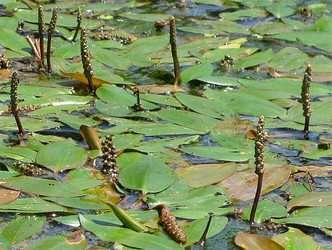
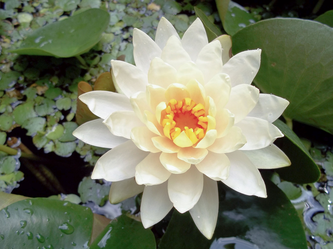
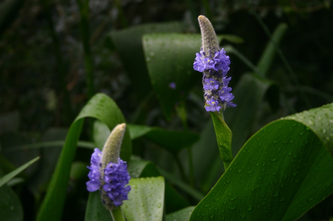
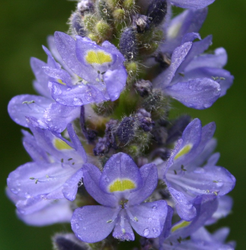
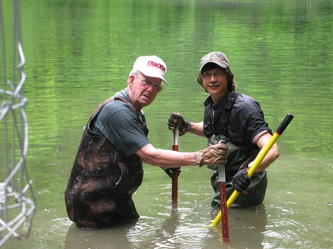
 RSS Feed
RSS Feed